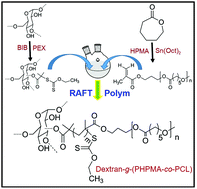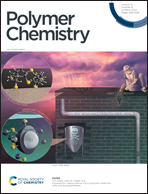Synthesis of an amphiphilic copolymer using biopolymer-dextran via a combination of ROP and RAFT techniques†
Abstract
Ring-opening polymerization (ROP) and reversible addition–fragmentation chain-transfer (RAFT) polymerization are efficient synthetic approaches to develop self-assembled copolymers with narrow dispersity (Đ). The main aim of this work is to develop a new pH-responsive amphiphilic graft copolymer [Dextran-g-(PHPMA-co-PCL)] comprised of dextran grafted with HPMA (hydroxypropyl methacrylate)-PCL (polycaprolactone) via the RAFT technique. Here, HPMA (as a monomer) has been modified using ε-caprolactone via the ROP technique to prepare a hydrophobic moiety. The chain length of HPMA-PCL has been varied to obtain graft copolymers with different hydrophobic segments. The controlled nature of the copolymer synthesis has been monitored using multiangle light scattering (MALS) attached to gel permeation chromatography (GPC). A fluorometric study has been performed to determine the critical micelle concentration (CMC) of the graft copolymer. Polymer chains can be efficiently self-assembled into spherical micelles in an aqueous solution as obvious from FESEM and TEM images. The suitability of the amphiphilic copolymer as a pH-responsive nanocarrier has been observed through an in vitro cumulative release study to deliver a model hydrophobic drug, dipyridamole.



 Please wait while we load your content...
Please wait while we load your content...